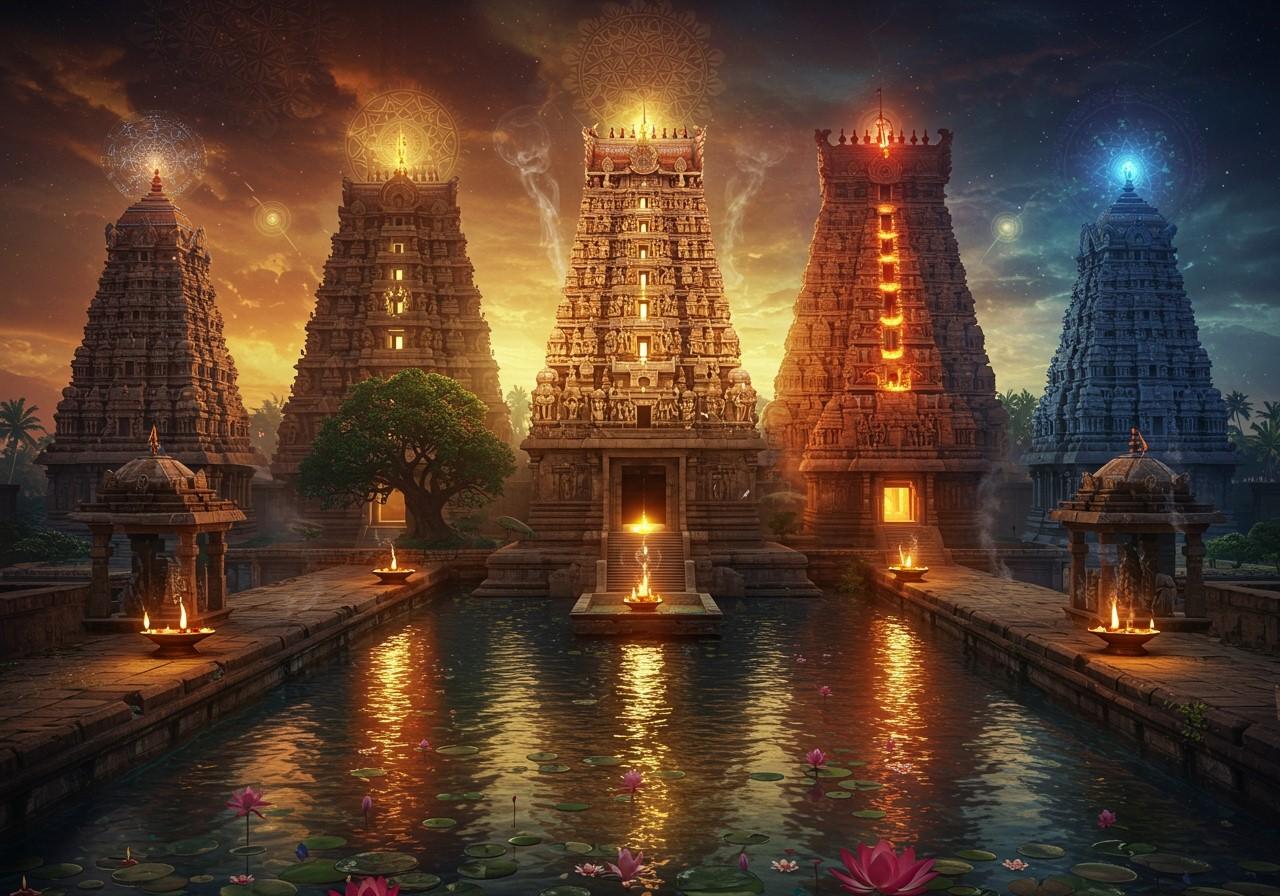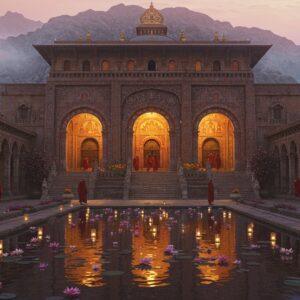
India, a land of ancient wisdom and vibrant spirituality, is home to a unique series of temples known as the Pancha Bhuta Sthalams. These sacred sites are dedicated to the five elements of nature – earth, water, fire, air, and space (Pancha Mahabhutas) – and offer a profound glimpse into the deep connection between the natural world and the divine.
These temples aren’t just architectural marvels; they are spiritual havens, each embodying one of the five elements. Understanding these temples involves exploring their architectural styles, the symbolism woven into their designs, and the ongoing efforts to preserve these cultural treasures for generations to come.
Temple Architecture: A Symphony of the Elements
The architectural style of the Pancha Bhuta Sthalam temples predominantly reflects the Dravidian style prevalent in South India, characterized by towering gopurams (gateways), intricate carvings, and vast courtyards. However, each temple has unique features that symbolize the specific element it represents.
- Ekambareswarar Temple, Kanchipuram (Earth): Dedicated to the Prithvi Lingam (Earth Lingam), this temple’s majestic gopuram symbolizes stability and rootedness, much like the earth itself. The temple’s vastness evokes a sense of groundedness and connection to Mother Earth.
- Jambukeswarar Temple, Tiruchirappalli (Water): This temple, dedicated to the Appu Lingam (Water Lingam), features a constant flow of water from an underground source in the sanctum. This unique feature beautifully embodies water’s fluidity, life-giving nature, and purifying qualities. The sanctum sanctorum, always gently bathed in water, creates a serene and calming atmosphere.
- Annamalaiyar Temple, Tiruvannamalai (Fire): Representing fire with the Agni Lingam, this temple is known for its perpetually burning sacred fire and the countless lamps that illuminate its halls. The vibrant energy of fire is palpable here, signifying its transformative and illuminating power.
- Sri Kalahasti Temple, Andhra Pradesh (Air): This temple’s unique Vayu Lingam (Air Lingam) is believed to be self-manifested, embodying the unseen yet omnipresent force of air. The temple’s open spaces and lofty architecture invite the element of air, creating a sense of lightness and freedom.
- Chidambaram Temple, Chidambaram (Space/Ether): Instead of a traditional lingam, this temple honors Nataraja, the cosmic dancer, symbolizing the boundless expanse of space and the dynamic energy of the universe. The temple’s architecture evokes a sense of vastness and the infinite possibilities of the cosmos.
These architectural elements beautifully highlight the deep connection between the temple structures and the natural elements they represent.
Symbolism in Temple Design: Reflecting the Cosmic Order
Temples in India are not mere structures; they are microcosms of the universe, embodying the principles of balance and harmony. The Pancha Bhuta Sthalams exemplify this concept by representing the five fundamental elements that constitute all of creation. Let’s explore the symbolism woven into the design of each temple:
Preservation Efforts and Challenges: Safeguarding Sacred Heritage
Preserving these ancient temples is a sacred duty, but it comes with its share of challenges. Environmental factors, the relentless march of urbanization, and the simple passage of time all pose threats to the structural integrity of these architectural marvels.
Conservation efforts focus on a delicate balance: maintaining the original aesthetics and spiritual aura of the temples while ensuring their structural stability for generations to come. Communities, government bodies, and dedicated organizations work hand in hand, employing both traditional techniques and advanced technology like 3D scanning for restoration projects.
How Poojn.in Helps You Connect with the Pancha Bhuta Temples
At Poojn.in, we understand the deep significance of these sacred sites and offer a wide range of items to enhance your spiritual journey. Whether you’re planning a pilgrimage or wish to create a sacred space in your home, we have everything you need:
- Brass Temple Items: From pure brass diyas and deepams for fire worship to brass water vessels for water temples, we offer a variety of items crafted with utmost care and reverence. You’ll also find special brass bells used in temple rituals and brass incense holders to honor the element of air.
- Puja Essentials: Prepare for your temple visit with our complete puja thalis containing all the necessary items. We also offer traditional cotton wicks for deepams, pure copper vessels for water offerings, and natural incense and dhoop for purification.
- Temple-Specific Items: Enhance your worship at each Pancha Bhuta Sthalam with our selection of temple-specific items. Find everything you need for Shiva puja at Ekambareswarar Temple, special offerings for Kalahasti Temple, and ritual items for Thiruvannamalai Temple worship.
We offer convenient home delivery across India. For personalized guidance in selecting the right puja items, reach out to us:
- Phone: 03369029784
- WhatsApp: 9476142738
Visit Poojn.in today to explore our complete collection of authentic temple puja items. Each product is carefully chosen to meet traditional specifications and temple requirements.
Note: Prices and availability may vary. Please check our website for the latest details.
Embracing the Legacy: A Timeless Journey
FAQs: Delving Deeper into the Pancha Bhuta Sthalams
Here are some common questions about the Pancha Bhuta Sthalams and their architectural significance:
What are the Pancha Bhuta Sthalam temples? The Pancha Bhuta Sthalams are five ancient temples dedicated to Lord Shiva, each representing one of the five fundamental elements: earth, water, fire, air, and space. Predominantly located in South India, they offer a unique blend of architectural brilliance and spiritual significance.
Why is the architecture of Pancha Bhuta Sthalam temples unique? Their architecture stands out because each temple is specifically designed to embody the element it represents. From the towering gopurams of the earth temple to the water flowing beneath the water temple, the architectural elements symbolize the unique qualities of each element.
How does symbolism play a role in the temple design? Symbolism is deeply ingrained in the design of these temples. Every aspect, from the layout and carvings to the materials used, reflects the specific element being honored. For example, the fire temple might incorporate flame motifs, while the air temple might feature open spaces and soaring structures.
What are the preservation efforts for these temples? Preservation efforts involve regular maintenance, restoration projects, and government initiatives aimed at protecting these cultural treasures. Local communities and heritage organizations also play a crucial role in safeguarding these sacred spaces.
What challenges do these temples face in preservation? Preserving these ancient wonders comes with challenges like environmental damage, pollution, and the natural wear and tear of time. Urban development encroaching upon these historic sites and limited resources for conservation also pose significant hurdles.
Can visitors experience the elemental themes in the Pancha Bhuta Sthalam temples? Absolutely! Visitors can deeply experience the elemental themes through the architecture, the rituals performed, and the overall ambiance of each temple. The unique design elements create a palpable connection with the natural world.
What is the importance of temple architecture in Indian culture? Temple architecture holds immense importance in Indian culture as it reflects religious beliefs, artistic expression, and historical continuity. These structures serve as a bridge between the spiritual and physical realms, offering spaces for worship, community gatherings, and cultural preservation.
Are there guided tours available for exploring these temples? Yes, guided tours are available to enrich your exploration of the Pancha Bhuta Sthalams. These tours offer valuable insights into the architecture, history, and spiritual significance of each temple, enhancing your understanding and appreciation of these sacred sites.


